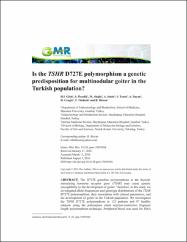| dc.contributor.author | Gözü, Hülya İliksu | |
| dc.contributor.author | Özçelik, S. | |
| dc.contributor.author | Aloglu, M. | |
| dc.contributor.author | Şahin, A. | |
| dc.contributor.author | Temiz, S. | |
| dc.contributor.author | Dayan, A. | |
| dc.contributor.author | Bircan, Rifat | |
| dc.date.accessioned | 2022-05-11T14:28:34Z | |
| dc.date.available | 2022-05-11T14:28:34Z | |
| dc.date.issued | 2016 | |
| dc.identifier.issn | 1676-5680 | |
| dc.identifier.uri | https://doi.org/10.4238/gmr.15038504 | |
| dc.identifier.uri | https://hdl.handle.net/20.500.11776/6872 | |
| dc.description.abstract | The D727E germline polymorphism in the thyroid-stimulating hormone receptor gene (TSHR) may cause genetic susceptibility to the development of goiter. Therefore, in this study we investigated allele frequencies and genotype distributions of the TSHR D727E polymorphism, their association with clinical parameters, and the development of goiter in the Turkish population. We investigated the TSHR D727E polymorphism in 123 patients and 97 healthy subjects using the polymerase chain reaction-restriction fragment length polymorphism technique. Peripheral blood was used for DNA extraction. Although no significant difference was found in TSHR D727E polymorphism frequencies between the patients with nodular goiters (26/123 patients, 21.1%) and the controls (12/97 patients, 12.4%) (P = 0.107), the frequency of the TSHR D727E polymorphism in the hyperthyroid+ subclinical hyperthyroid patient groups (23%) was significantly higher than in the control subjects (12.4%) (P = 0.024). In this study, nodular goiter presented significantly earlier in GC genotype patients (mean age 35 years) than in CC genotype patients (mean age 42 years) in the hyperthyroid group (P = 0.009). More importantly, TSH levels in the GC variant controls were closely significant lower (1.26 +/- 0.49) than in the CC variant controls (1.74 +/- 0.84) (P = 0.053). The TSHR D727E polymorphism might be involved in the pathogenesis of toxic multinodular goiter (TMNG). Moreover, this polymorphism might be an indication of early-onset TMNG. However, development of MNG is multifactorial. Therefore, further case-control studies with larger populations are required to verify these observations. | en_US |
| dc.language.iso | eng | en_US |
| dc.publisher | Funpec-Editora | en_US |
| dc.identifier.doi | 10.4238/gmr.15038504 | |
| dc.rights | info:eu-repo/semantics/openAccess | en_US |
| dc.subject | Thyroid | en_US |
| dc.subject | Toxic MNG | en_US |
| dc.subject | TSHR D727E | en_US |
| dc.subject | Polymorphism | en_US |
| dc.subject | Stimulating Hormone-Receptor | en_US |
| dc.subject | Human Thyrotropin Receptor | en_US |
| dc.subject | Familial Euthyroid Goiter | en_US |
| dc.subject | Germline Polymorphism | en_US |
| dc.subject | Thyroid-Diseases | en_US |
| dc.subject | Graves-Disease | en_US |
| dc.subject | Mutations | en_US |
| dc.subject | Adolescents | en_US |
| dc.subject | Twin | en_US |
| dc.subject | Association | en_US |
| dc.title | Is the TSHR D727E polymorphism a genetic predisposition for multinodular goiter in the Turkish population? | en_US |
| dc.type | article | en_US |
| dc.relation.ispartof | Genetics and Molecular Research | en_US |
| dc.department | Fakülteler, Fen Edebiyat Fakültesi, Biyoloji Bölümü | en_US |
| dc.authorid | 0000-0001-5291-8620 | |
| dc.identifier.volume | 15 | en_US |
| dc.identifier.issue | 3 | en_US |
| dc.institutionauthor | Bircan, Rifat | |
| dc.relation.publicationcategory | Makale - Uluslararası Hakemli Dergi - Kurum Öğretim Elemanı | en_US |
| dc.authorscopusid | 16241650400 | |
| dc.authorscopusid | 57190948701 | |
| dc.authorscopusid | 57190942272 | |
| dc.authorscopusid | 57226264250 | |
| dc.authorscopusid | 16302402600 | |
| dc.authorscopusid | 57190950157 | |
| dc.authorscopusid | 57220351063 | |
| dc.authorwosid | Bircan, Rıfat/A-7344-2018 | |
| dc.identifier.wos | WOS:000384881300073 | en_US |
| dc.identifier.scopus | 2-s2.0-84984604262 | en_US |
| dc.identifier.pmid | 27525921 | en_US |



















